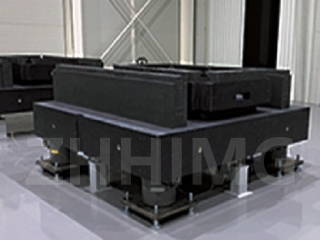Black granite guideways, also known as granite linear guides, are precision engineered products used in a variety of industrial applications where high accuracy and stability are required. These guideways are made from high-quality black granite, which is a natural stone with exceptional mechanical and thermal properties. Assembling, testing and calibrating black granite guideways requires special skills and techniques to ensure that they meet the required specifications. In this article, we discuss the process of assembling, testing, and calibrating black granite guideways.
Assembling Black Granite Guideways
The first step in assembling black granite guideways is to clean the surfaces thoroughly. Any debris or dirt on the surfaces can affect the accuracy of the guideways. The surfaces of the guideways should be clean, dry, and free from oil, grease, or any other contaminants. Once the surfaces are clean, the granite blocks or rails are assembled to form the guideway. The assembly process involves the use of precision tools to align the components accurately.
In some cases, the guideways may have pre-installed components such as ball bearings or linear guides. These components should be checked for compatibility and proper installation. The guideway should be assembled using the manufacturer's recommended torque and pressure specifications.
Testing Black Granite Guideways
After assembly, the black granite guideways are tested to ensure that they meet the required specifications. The testing process involves the use of precision instruments such as laser interferometers, dial indicators, and surface plates. The testing process involves the following steps:
1. Checking for straightness: The guideway is placed on a surface plate, and a dial indicator is used to check for any deviation from straightness along the length of the guideway.
2. Checking for flatness: The surface of the guideway is checked for flatness using a surface plate and a dial indicator.
3. Checking for parallelism: The two sides of the guideway are checked for parallelism using a laser interferometer.
4. Measuring the sliding friction: The guideway is loaded with a known weight, and a force gauge is used to measure the frictional force required to slide the guideway.
Calibrating Black Granite Guideways
Calibration is the process of adjusting the guideways to meet the required specifications. It involves making fine adjustments to the guideways to ensure that they are straight, flat, and parallel. The calibration process is done using precision instruments and requires a high level of skill and expertise. The calibration process involves:
1. Aligning the guideway: The guideway is aligned using precision tools such as a micrometer or dial indicator to achieve the required straightness, flatness, and parallelism.
2. Checking for motion errors: The guideway is tested for motion errors using a laser interferometer to ensure that there are no deviations from the desired path.
3. Adjusting compensation factors: Any deviations found during testing are adjusted using compensation factors such as temperature, load, and geometric errors.
In conclusion, assembling, testing, and calibrating black granite guideways requires a high level of skill and expertise. The process involves the use of precision instruments, cleanliness, and following the manufacturer's recommended specifications. It is essential to maintain a clean environment and use the recommended torque and pressure specifications during assembly. Testing and calibration are done using precision instruments such as laser interferometers and dial indicators. Calibration involves aligning the guideways, checking for motion errors, and adjusting compensation factors. With proper assembly, testing, and calibration, black granite guideways can provide high accuracy and stability in industrial applications.
Post time: Jan-30-2024

